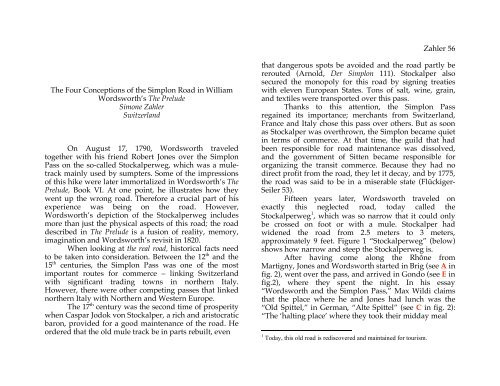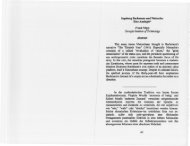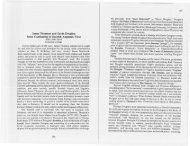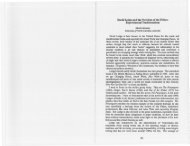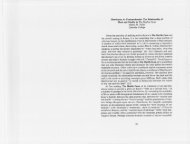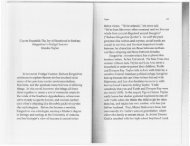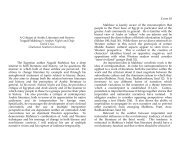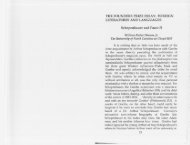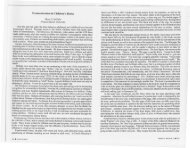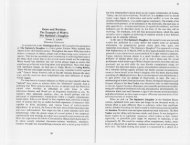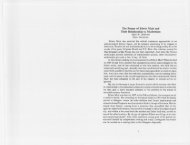The Four Conceptions of the Simplon Road in William Wordsworth's ...
The Four Conceptions of the Simplon Road in William Wordsworth's ...
The Four Conceptions of the Simplon Road in William Wordsworth's ...
You also want an ePaper? Increase the reach of your titles
YUMPU automatically turns print PDFs into web optimized ePapers that Google loves.
Zahler 56<strong>The</strong> <strong>Four</strong> <strong>Conceptions</strong> <strong>of</strong> <strong>the</strong> <strong>Simplon</strong> <strong>Road</strong> <strong>in</strong> <strong>William</strong>Wordsworth’s <strong>The</strong> PreludeSimone ZahlerSwitzerlandOn August 17, 1790, Wordsworth traveledtoge<strong>the</strong>r with his friend Robert Jones over <strong>the</strong> <strong>Simplon</strong>Pass on <strong>the</strong> so-called Stockalperweg, which was a muletrackma<strong>in</strong>ly used by sumpters. Some <strong>of</strong> <strong>the</strong> impressions<strong>of</strong> this hike were later immortalized <strong>in</strong> Wordsworth’s <strong>The</strong>Prelude, Book VI. At one po<strong>in</strong>t, he illustrates how <strong>the</strong>ywent up <strong>the</strong> wrong road. <strong>The</strong>refore a crucial part <strong>of</strong> hisexperience was be<strong>in</strong>g on <strong>the</strong> road. However,Wordsworth’s depiction <strong>of</strong> <strong>the</strong> Stockalperweg <strong>in</strong>cludesmore than just <strong>the</strong> physical aspects <strong>of</strong> this road; <strong>the</strong> roaddescribed <strong>in</strong> <strong>The</strong> Prelude is a fusion <strong>of</strong> reality, memory,imag<strong>in</strong>ation and Wordsworth’s revisit <strong>in</strong> 1820.When look<strong>in</strong>g at <strong>the</strong> real road, historical facts needto be taken <strong>in</strong>to consideration. Between <strong>the</strong> 12 th and <strong>the</strong>15 th centuries, <strong>the</strong> <strong>Simplon</strong> Pass was one <strong>of</strong> <strong>the</strong> mostimportant routes for commerce – l<strong>in</strong>k<strong>in</strong>g Switzerlandwith significant trad<strong>in</strong>g towns <strong>in</strong> nor<strong>the</strong>rn Italy.However, <strong>the</strong>re were o<strong>the</strong>r compet<strong>in</strong>g passes that l<strong>in</strong>kednor<strong>the</strong>rn Italy with Nor<strong>the</strong>rn and Western Europe.<strong>The</strong> 17 th century was <strong>the</strong> second time <strong>of</strong> prosperitywhen Caspar Jodok von Stockalper, a rich and aristocraticbaron, provided for a good ma<strong>in</strong>tenance <strong>of</strong> <strong>the</strong> road. Heordered that <strong>the</strong> old mule track be <strong>in</strong> parts rebuilt, eventhat dangerous spots be avoided and <strong>the</strong> road partly bererouted (Arnold, Der <strong>Simplon</strong> 111). Stockalper alsosecured <strong>the</strong> monopoly for this road by sign<strong>in</strong>g treatieswith eleven European States. Tons <strong>of</strong> salt, w<strong>in</strong>e, gra<strong>in</strong>,and textiles were transported over this pass.Thanks to this attention, <strong>the</strong> <strong>Simplon</strong> Passrega<strong>in</strong>ed its importance; merchants from Switzerland,France and Italy chose this pass over o<strong>the</strong>rs. But as soonas Stockalper was overthrown, <strong>the</strong> <strong>Simplon</strong> became quiet<strong>in</strong> terms <strong>of</strong> commerce. At that time, <strong>the</strong> guild that hadbeen responsible for road ma<strong>in</strong>tenance was dissolved,and <strong>the</strong> government <strong>of</strong> Sitten became responsible fororganiz<strong>in</strong>g <strong>the</strong> transit commerce. Because <strong>the</strong>y had nodirect pr<strong>of</strong>it from <strong>the</strong> road, <strong>the</strong>y let it decay, and by 1775,<strong>the</strong> road was said to be <strong>in</strong> a miserable state (Flückiger-Seiler 53).Fifteen years later, Wordsworth traveled onexactly this neglected road, today called <strong>the</strong>Stockalperweg 1 , which was so narrow that it could onlybe crossed on foot or with a mule. Stockalper hadwidened <strong>the</strong> road from 2.5 meters to 3 meters,approximately 9 feet. Figure 1 “Stockalperweg” (below)shows how narrow and steep <strong>the</strong> Stockalperweg is.After hav<strong>in</strong>g come along <strong>the</strong> Rhône fromMartigny, Jones and Wordsworth started <strong>in</strong> Brig (see A <strong>in</strong>fig. 2), went over <strong>the</strong> pass, and arrived <strong>in</strong> Gondo (see E <strong>in</strong>fig.2), where <strong>the</strong>y spent <strong>the</strong> night. In his essay“Wordsworth and <strong>the</strong> <strong>Simplon</strong> Pass,” Max Wildi claimsthat <strong>the</strong> place where he and Jones had lunch was <strong>the</strong>“Old Spittel,” <strong>in</strong> German, “Alte Spittel” (see C <strong>in</strong> fig. 2):“<strong>The</strong> ‘halt<strong>in</strong>g place’ where <strong>the</strong>y took <strong>the</strong>ir midday meal1 Today, this old road is rediscovered and ma<strong>in</strong>ta<strong>in</strong>ed for tourism.
Wordsworth 57Zahler 58Figure 1. Stockalperweg; <strong>in</strong> Klaus Anderegg, Gondoschlucht(<strong>Simplon</strong>: Ecomuseum 2004)(6.565/566) is <strong>the</strong> old ‘hospice’ known as StockalperSpittal […] built <strong>in</strong> 1667 by Baron Stockalper as a storesdepot and shelter for muleteers and o<strong>the</strong>r travelers”(227).Figure 2. Wordsworth’s Hike Across <strong>the</strong> Alps; adapted from “Übersichtzum Ecomuseum <strong>Simplon</strong> […]” <strong>in</strong> Klaus Aerni, <strong>Simplon</strong> – Passwege undMuseen (Bern: Geographica Bernensia, 2003) 15.
Wordsworth 59In his 1805 version <strong>of</strong> <strong>The</strong> Prelude, Wordsworthdescribes <strong>the</strong> ascent towards <strong>the</strong> Spittel as follows:Upturn<strong>in</strong>g with a bandOf travellers, from <strong>the</strong> Valais we had clombAlong <strong>the</strong> road that leads to Italy;A length <strong>of</strong> hours, mak<strong>in</strong>g <strong>of</strong> <strong>the</strong>se our guides,Did we advance, and, hav<strong>in</strong>g reached <strong>the</strong> <strong>in</strong>nAmong <strong>the</strong> mounta<strong>in</strong>s, we toge<strong>the</strong>r ate […].(6.494-499)In this passage, it becomes clear that <strong>the</strong>y jo<strong>in</strong>ed a band<strong>of</strong> travelers, probably local merchants with mules s<strong>in</strong>ce<strong>the</strong>y were “mak<strong>in</strong>g <strong>of</strong> <strong>the</strong>se our guides.” It is surpris<strong>in</strong>gthat Wordsworth does not give <strong>the</strong> name <strong>of</strong> <strong>the</strong> specificpass that <strong>the</strong>y traveled. Ra<strong>the</strong>r than say<strong>in</strong>g that <strong>the</strong>y werecross<strong>in</strong>g <strong>the</strong> <strong>Simplon</strong> Pass, it is “<strong>the</strong> road that leads toItaly.” <strong>The</strong> fact that <strong>the</strong> purpose <strong>of</strong> <strong>the</strong> road it is to take<strong>the</strong>m across <strong>the</strong> Alps <strong>in</strong>to Italy becomes central. <strong>The</strong> road,<strong>the</strong>refore, serves a specific purpose and loses its identity;it could stand for any road across <strong>the</strong> Alps.After hav<strong>in</strong>g eaten <strong>the</strong>ir d<strong>in</strong>ner at <strong>the</strong> Spittel, <strong>the</strong>irself-proclaimed guides roseLeav<strong>in</strong>g us at <strong>the</strong> board. Erelong we followed,Descend<strong>in</strong>g by <strong>the</strong> beaten road that ledRight to a rivulet’s edge, and <strong>the</strong>re broke <strong>of</strong>f;(6.501-503)Expressions such as “beaten road” and “broke <strong>of</strong>f”convey <strong>the</strong> true nature about <strong>the</strong> <strong>Simplon</strong> road, whichwas at that time <strong>in</strong> a miserable condition. At this momentit seems almost impossible that this road had just acentury ago been one <strong>of</strong> <strong>the</strong> most important commerceroutes bridg<strong>in</strong>g <strong>the</strong> Alps and l<strong>in</strong>k<strong>in</strong>g Nor<strong>the</strong>rn withSou<strong>the</strong>rn Europe.Zahler 60<strong>The</strong> road and <strong>the</strong> condition <strong>of</strong> <strong>the</strong> road are at <strong>the</strong>center <strong>of</strong> Wordsworth’s attention once it breaks <strong>of</strong>f. S<strong>in</strong>ce<strong>the</strong> road ended <strong>the</strong>re:<strong>The</strong> only track now visible was oneUpon <strong>the</strong> fur<strong>the</strong>r side, right opposite,And up a l<strong>of</strong>ty mounta<strong>in</strong>. (6.504-506)In <strong>the</strong> essay mentioned before, Wildi located <strong>the</strong> placewhere <strong>the</strong> two travelers apparently lost <strong>the</strong>ir way as apo<strong>in</strong>t south <strong>of</strong> <strong>the</strong> village <strong>of</strong> Gabi (see D <strong>in</strong> fig.2), about700 m from <strong>the</strong> entrance <strong>of</strong> <strong>the</strong> Gondo Gorge, where amule track led up to <strong>the</strong> hamlet <strong>of</strong> Freeberg (228).It puzzled Wordsworth and Jones that <strong>the</strong>y didnot overtake <strong>the</strong> “guides,” but not until <strong>the</strong>y met apeasant, were <strong>the</strong>y really aware <strong>of</strong> <strong>the</strong>ir mistake. <strong>The</strong>encounter with <strong>the</strong> peasant was important because hewas <strong>the</strong> one who opened <strong>the</strong>ir eyes that <strong>the</strong>y had alreadycrossed <strong>the</strong> Alps and had to go down now. What thatmeans is that Wordsworth had missed one <strong>of</strong> <strong>the</strong> mosthighly anticipated spiritual moments <strong>of</strong> his tour: be<strong>in</strong>g ontop <strong>of</strong> <strong>the</strong> Alps. In fact, <strong>the</strong>y had gone down about 800 m(2400 feet) s<strong>in</strong>ce <strong>the</strong> peak (see fig. 3, next page).
Wordsworth 61Figure 3.Mounta<strong>in</strong>top: adapted from “ViaStockalper” <strong>in</strong> PeterSalmann, Das Neue Kultur- und Wanderpackage Über den <strong>Simplon</strong>(<strong>Simplon</strong>: Ecomuseum, 2004).After hav<strong>in</strong>g missed <strong>the</strong> climactic moment at <strong>the</strong>mounta<strong>in</strong>top, Wordsworth <strong>in</strong>cludes a passage <strong>in</strong> <strong>The</strong>Prelude that talks about <strong>the</strong> power <strong>of</strong> imag<strong>in</strong>ation andrecollect<strong>in</strong>g. Here, he suddenly leaves <strong>the</strong> road that hetraveled <strong>in</strong> 1790 and starts to celebrate <strong>the</strong> creative poweras he experiences it at <strong>the</strong> present moment. In order torecognize <strong>the</strong> positive aspects <strong>of</strong> <strong>the</strong> experience when hehad missed <strong>the</strong> climax, he had to literally step out <strong>of</strong> <strong>the</strong>sett<strong>in</strong>g and leave all roads beh<strong>in</strong>d him. Only by do<strong>in</strong>g sowas he able to get over his past disappo<strong>in</strong>tment andmove to <strong>the</strong> apocalyptic Gondo Rav<strong>in</strong>e passage.Romantic scholar Robert A. Br<strong>in</strong>kley remarks that “[a]sWordsworth recalled that <strong>in</strong>cident, <strong>the</strong> poem envisionedtwo moments <strong>in</strong> time: a past (1790) and a present (whenWordsworth is tell<strong>in</strong>g <strong>the</strong> story)” (122).Zahler 62<strong>The</strong> act <strong>of</strong> remember<strong>in</strong>g <strong>the</strong> road <strong>in</strong> <strong>the</strong> event <strong>of</strong>writ<strong>in</strong>g <strong>The</strong> Prelude implies passage <strong>of</strong> time. S<strong>in</strong>ce <strong>in</strong> thissection <strong>the</strong> act <strong>of</strong> remember<strong>in</strong>g is central, <strong>the</strong> <strong>Simplon</strong>road that Wordsworth describes is not only <strong>the</strong> real roadthat <strong>the</strong>y traveled on <strong>in</strong> 1790, but becomes a comb<strong>in</strong>ation<strong>of</strong> <strong>the</strong> real road and <strong>the</strong> remembered road. Through <strong>the</strong>action <strong>of</strong> remember<strong>in</strong>g, also <strong>the</strong> passage <strong>of</strong> time becomessignificant: Wordsworth claims that <strong>in</strong> 1790 he “was lost<strong>in</strong> a cloud” (6.529), which I call <strong>the</strong> cloud <strong>of</strong> expectationand <strong>the</strong> result<strong>in</strong>g disappo<strong>in</strong>tment. <strong>The</strong> cloud bl<strong>in</strong>ded himfrom enjoy<strong>in</strong>g <strong>the</strong> encounter with <strong>the</strong> peasant, and <strong>the</strong>only th<strong>in</strong>g he could th<strong>in</strong>k <strong>of</strong> was his disappo<strong>in</strong>tment. Butwhen compos<strong>in</strong>g <strong>the</strong> poem <strong>in</strong> 1804, he declares that“now, recover<strong>in</strong>g, to my soul I say / ‘I recognize thyglory’” (6.531-32). <strong>The</strong> word “recover<strong>in</strong>g” suggests that <strong>in</strong><strong>the</strong> moment <strong>of</strong> compos<strong>in</strong>g <strong>the</strong> poem, he accepts hisdisappo<strong>in</strong>tment; through remember<strong>in</strong>g he recovers from<strong>the</strong> sadness he felt at that spot <strong>of</strong> time <strong>in</strong> <strong>the</strong> past. Thismeans that, as Br<strong>in</strong>kley calls it, he now “f<strong>in</strong>ds thatGreatness dwells <strong>the</strong>re, <strong>in</strong> <strong>the</strong> experience <strong>of</strong> be<strong>in</strong>g lost”(123), which could only happen through <strong>the</strong> passage <strong>of</strong>time.Fur<strong>the</strong>rmore, while writ<strong>in</strong>g <strong>the</strong> poem <strong>in</strong> 1804,<strong>the</strong>re was no road that embodied all <strong>the</strong> constra<strong>in</strong>ts andexpectations that come with travel<strong>in</strong>g; and thus <strong>in</strong> 1804,Wordsworth was able to experience <strong>the</strong> spiritual momentto which he had aspired on <strong>the</strong> road. Clearly, <strong>the</strong>recollection <strong>of</strong> past experiences enables him to recognizethat “Our dest<strong>in</strong>y, our nature, and our home, / Is with<strong>in</strong>f<strong>in</strong>itude – and only <strong>the</strong>re” (6.539-540). This means thatWordsworth has f<strong>in</strong>ally accepted that <strong>the</strong> spiritualmoment, which he had desired to experience on <strong>the</strong> top
Wordsworth 63<strong>of</strong> <strong>the</strong> Alps, is not tak<strong>in</strong>g place on <strong>the</strong> road, but laterwhen compos<strong>in</strong>g his poem many years after thatmoment. <strong>The</strong> key to imag<strong>in</strong>ation is <strong>the</strong>refore <strong>the</strong> fusion <strong>of</strong><strong>the</strong> real and <strong>the</strong> remembered road.In <strong>the</strong> Gondo Rav<strong>in</strong>e passage, Wordsworth allowshimself to step away from <strong>the</strong> factuality <strong>of</strong> his memoriesand to fuse reality with imag<strong>in</strong>ation <strong>in</strong> order to describean apocalyptic moment. Many scholars question <strong>the</strong>accuracy <strong>of</strong> some details <strong>in</strong> this passage s<strong>in</strong>ce <strong>in</strong>Descriptive Sketches some <strong>of</strong> <strong>the</strong> same descriptions arelocated <strong>in</strong> o<strong>the</strong>r places. For example, <strong>the</strong> “torrentsshoot<strong>in</strong>g from <strong>the</strong> clear blue sky” (6.561) are orig<strong>in</strong>allyfrom <strong>the</strong> region around Lake Como (Bernhardt-Kabisch381). What that means <strong>in</strong> terms <strong>of</strong> roads is thatWordsworth <strong>in</strong>troduces now a third aspect <strong>of</strong> <strong>the</strong> road:<strong>the</strong> imag<strong>in</strong>ative road which he now calls “fellow-traveler.”Imag<strong>in</strong>ation, to which he had just written an<strong>in</strong>vocation, <strong>the</strong>refore, is at <strong>the</strong> center <strong>of</strong> his writ<strong>in</strong>g. Thismeans that hav<strong>in</strong>g lost his road now allows him tobecome more creative, to let his imag<strong>in</strong>ation craft <strong>the</strong>Gondo Rav<strong>in</strong>e while at <strong>the</strong> same time remember<strong>in</strong>g <strong>the</strong>sublimity <strong>of</strong> <strong>the</strong> true scenery. <strong>The</strong> contradictory character<strong>of</strong> <strong>the</strong> Gondo Rav<strong>in</strong>e, which exists <strong>in</strong> nature as well as <strong>in</strong>Wordsworth’s m<strong>in</strong>d, is discernible <strong>in</strong> his treatment <strong>of</strong> <strong>the</strong>road itself.<strong>The</strong> same road that leads through <strong>the</strong> GondoGorge plays an essential role throughout <strong>the</strong> wholecross<strong>in</strong>g <strong>of</strong> <strong>the</strong> Alps, but now even more than beforebecomes part <strong>of</strong> <strong>the</strong> experience and at <strong>the</strong> same timeexists outside <strong>of</strong> it <strong>in</strong> his imag<strong>in</strong>ation:[…]downwards we hurried fast,And entered with <strong>the</strong> road which we had missedInto a narrow chasm. (6.551-553)Zahler 64<strong>The</strong> fact that <strong>the</strong>y “entered with <strong>the</strong> road” - <strong>in</strong>stead <strong>of</strong> justenter<strong>in</strong>g <strong>the</strong> chasm on <strong>the</strong> road - gives <strong>the</strong> path <strong>the</strong>quality <strong>of</strong> be<strong>in</strong>g an entity <strong>of</strong> its own, <strong>in</strong>dicat<strong>in</strong>g that <strong>the</strong>road had been <strong>the</strong>re all <strong>the</strong> time, even though <strong>the</strong>y didnot see it at first. In addition, <strong>the</strong> personification <strong>of</strong> <strong>the</strong>road, which is given with <strong>the</strong> word “enter” and <strong>the</strong>conjunction “with,” turns <strong>the</strong> road <strong>in</strong>to a hik<strong>in</strong>gcompanion. Thus, <strong>the</strong> road loses its characteristic <strong>of</strong> be<strong>in</strong>gan outside entity that before he had just called “<strong>the</strong> roadthat leads to Italy” (6.496).Hav<strong>in</strong>g missed <strong>the</strong> road before, he now suddenlygives <strong>the</strong> road a face. Now it serves more than just to <strong>the</strong>purpose <strong>of</strong> liv<strong>in</strong>g up to its function <strong>of</strong> tak<strong>in</strong>g <strong>the</strong> travelerto <strong>the</strong> expected dest<strong>in</strong>ation. <strong>The</strong> road has now a character<strong>of</strong> its own and is different from all <strong>the</strong> roads taken before.<strong>The</strong> same can be observed <strong>in</strong> <strong>the</strong> subsequent l<strong>in</strong>es:<strong>The</strong> brook and roadWere fellow-travellers <strong>in</strong> this gloomy pass,And with <strong>the</strong>m did we journey several hoursAt a slow step. (6.553-556)This sentence, like <strong>the</strong> one before, implies thatWordsworth’s notion <strong>of</strong> <strong>the</strong> road has changed. <strong>The</strong> word“fellow-travellers” is ambiguous. On <strong>the</strong> one hand, itsymbolizes that <strong>the</strong> brook and <strong>the</strong> road have been fellowtravelersthrough this chasm for years. Thiscompanionship can be <strong>in</strong>terpreted as be<strong>in</strong>g a symbiosis <strong>of</strong>two entities that are not very alike: <strong>the</strong> road is an artificialconstruct whereas <strong>the</strong> brook follows its natural course,and <strong>the</strong> road does not move whereas <strong>the</strong> brook flows.<strong>The</strong>refore, by equat<strong>in</strong>g <strong>the</strong> brook with <strong>the</strong> road,Wordsworth achieves a more natural notion <strong>of</strong> <strong>the</strong> road
Wordsworth 65and anticipates <strong>the</strong> movement <strong>of</strong> <strong>the</strong> travelers on aseem<strong>in</strong>gly flow<strong>in</strong>g road.On <strong>the</strong> o<strong>the</strong>r hand, this sentence can also be readso that <strong>the</strong> brook and <strong>the</strong> road are both fellow-travelers <strong>of</strong>Wordsworth and Jones. Wordsworth does not use <strong>the</strong>pronoun “our” before “fellow-travellers,” but <strong>the</strong> factthat he writes “with <strong>the</strong>m did we journey” <strong>in</strong>dicates thatsuddenly <strong>the</strong> road is at <strong>the</strong> center <strong>of</strong> <strong>the</strong>ir attention,whereas while cross<strong>in</strong>g <strong>the</strong> Alps it had just been <strong>the</strong>means to an end. Thus, <strong>the</strong> road is suddenly thisambiguous entity; on <strong>the</strong> one hand it is part <strong>of</strong> <strong>the</strong> hike(almost as if it moves itself), but also an outside entitythat exists apart from travelers who pass through hischasm.<strong>The</strong> fact that Wordsworth’s notion <strong>of</strong> <strong>the</strong> road haschanged after <strong>the</strong> <strong>in</strong>cident <strong>of</strong> miss<strong>in</strong>g it is nowexaggerated through <strong>the</strong> pace <strong>of</strong> <strong>the</strong> two hikers. After <strong>the</strong>peasant told <strong>the</strong>m that <strong>the</strong>y were on <strong>the</strong> wrong path,Wordsworth claims: “downwards we hurried fast,” but<strong>the</strong> hike through <strong>the</strong> gorge, which is supposed to take alittle more than an hour, is described as a journey <strong>of</strong>“several hours / At a slow step.” This <strong>in</strong>dicates that <strong>the</strong>ysuddenly changed <strong>the</strong> speed <strong>in</strong> order to start enjoy<strong>in</strong>g<strong>the</strong>ir hike, and <strong>the</strong>y were perhaps hop<strong>in</strong>g that this slowerpace would keep <strong>the</strong>m from miss<strong>in</strong>g ano<strong>the</strong>r importantmoment.<strong>The</strong> act <strong>of</strong> remember<strong>in</strong>g <strong>the</strong> road and blend<strong>in</strong>g itwith imag<strong>in</strong>ation contributes to his recognition <strong>of</strong> <strong>the</strong> realglory <strong>of</strong> that moment. F<strong>in</strong>d<strong>in</strong>g sublimity <strong>in</strong> nature,<strong>the</strong>refore, also has to do with passage <strong>of</strong> time. We will seethat <strong>the</strong>re is even a fourth aspect <strong>in</strong> Wordsworth’sconception <strong>of</strong> <strong>the</strong> <strong>Simplon</strong> road; <strong>the</strong> revisited road.However, before discuss<strong>in</strong>g Wordsworth’s return andZahler 66revision, we have to look at what happened <strong>in</strong> this regionbetween 1790 and 1820 (when he revisited <strong>the</strong> <strong>Simplon</strong>Pass): Napoleon’s armies had occupied Switzerland, andhe gave orders to build a “Kunststrasse” 2 over <strong>the</strong><strong>Simplon</strong> that changed <strong>the</strong> face and <strong>the</strong> perception <strong>of</strong> <strong>the</strong>pass forever.When Napoleon assumed power, he immediatelysaw <strong>the</strong> strategic importance <strong>of</strong> <strong>the</strong> <strong>Simplon</strong> Pass as <strong>the</strong>shortest connection between Paris and Milan; <strong>The</strong> key to<strong>the</strong> South was <strong>the</strong> <strong>Simplon</strong> Pass. In 1798, he overthrew<strong>the</strong> Swiss confederation and turned it <strong>in</strong>to a vassal statecalled Helvetic Republic. In 1798 and 1799, his troops<strong>in</strong>vaded <strong>the</strong> Canton Wallis (<strong>the</strong> French word is Vallais)and robbed, plundered, and devastated <strong>the</strong> whole areaby burn<strong>in</strong>g many villages: many Swiss were murdered.Certa<strong>in</strong> parts <strong>of</strong> this region were occupied for over 14years. Henceforth, enormous suffer<strong>in</strong>g, hunger andmisery overcame <strong>the</strong> villages along <strong>the</strong> <strong>Simplon</strong> Pass(Arnold, Der <strong>Simplon</strong> 156).On May 6, 1800, Napoleon sent a thousandFrenchmen over <strong>the</strong> <strong>Simplon</strong> to <strong>in</strong>spect <strong>the</strong> road. OnceNapoleon had conquered Milan, on September 7, 1800, heordered that <strong>the</strong> <strong>Simplon</strong> Pass be enlarged. In <strong>the</strong> third2 <strong>Road</strong> construction <strong>in</strong> <strong>the</strong> mounta<strong>in</strong>s has always been very difficult. It was not until1805 that <strong>in</strong> Switzerland <strong>the</strong> Alps could be crossed <strong>in</strong> carriages on so called “Kunststrassen”(artistic roads). <strong>The</strong>re was a need for such roads because at that time <strong>the</strong> ma<strong>in</strong> roads had to beenlarged for coaches, and <strong>the</strong>y also had to avoid sharp curves and steep <strong>in</strong>cl<strong>in</strong>es. <strong>The</strong> word“Kunst” has some <strong>in</strong>terest<strong>in</strong>g connotations. <strong>The</strong> etymology <strong>of</strong> this word comes from “können”(to be able), which comes from Old German “kunnan” (<strong>in</strong>tellectually be<strong>in</strong>g able to, to know, tounderstand). It <strong>the</strong>refore connotes knowledge, wisdom and science. On <strong>the</strong> o<strong>the</strong>r hand, <strong>the</strong>word “Kunst,” and especially its adjective “künstlich/ artifiziell” (artificial) is also used todescribe th<strong>in</strong>gs that are artificially made. <strong>The</strong> root <strong>of</strong> “artifiziell” comes from <strong>the</strong> Lat<strong>in</strong> word“artificium” (ars=art, ficium from facere = mak<strong>in</strong>g). This means that <strong>the</strong>re is a strong contrastbetween nature and science <strong>in</strong> <strong>the</strong> word “Kunst.” Consequently, a “Kunststrasse” rem<strong>in</strong>ds <strong>the</strong>traveler that <strong>the</strong> artificial constructs on which he f<strong>in</strong>ds himself are contrary to nature.
Wordsworth 67article <strong>of</strong> this decree, he wrote: “Le chem<strong>in</strong> depuis Brigueà Domo d’Ossola sera rendu practicable pour les canons”[<strong>the</strong> road between Brig and Domo d’Ossola shall be madeaccessible for cannons] (qtd. <strong>in</strong> Campana et al. 9). Clearly,<strong>the</strong> idea beh<strong>in</strong>d <strong>the</strong> reconstruction <strong>of</strong> this road was that itwould foremost serve military purposes ra<strong>the</strong>r thanbe<strong>in</strong>g used for commercial traffic. Napoleon decided that<strong>the</strong> Cisalp<strong>in</strong>e Republic had to build <strong>the</strong> section fromDomodossola to Gaby (28 kilometers) and to support <strong>the</strong>road construction monthly with 50,000 Francs. France, on<strong>the</strong> o<strong>the</strong>r hand, built <strong>the</strong> road from Brig to Gabi (34kilometers) and used <strong>the</strong> same amount <strong>of</strong> money(Flückiger-Seiler 54). <strong>The</strong> Wallis had to supply <strong>the</strong>m witha certa<strong>in</strong> number corvée labor (peasants who did unpaidwork as a form <strong>of</strong> tax), which added to <strong>the</strong> misery <strong>of</strong> <strong>the</strong>families who lived near <strong>the</strong> <strong>Simplon</strong> Pass.<strong>The</strong> Gondo Gorge (see fig.4), where Wordsworthhad experienced an apocalyptic moment, was changed<strong>the</strong> most by <strong>the</strong> construction. To build a gallery through<strong>the</strong> Gondo Rav<strong>in</strong>e posed enormous difficulties for all <strong>the</strong>eng<strong>in</strong>eers and workers. <strong>The</strong> rock was extremely hard,and <strong>the</strong>y calculated that it was go<strong>in</strong>g to take two years tobuild it, which was unacceptable to Napoleon. <strong>The</strong>refore,<strong>in</strong> order to speed <strong>the</strong> construction up, <strong>the</strong>y decided tohave two cuts. <strong>The</strong> exterior wall, however, was so steepthat no worker could put a foot <strong>in</strong>to <strong>the</strong> ledges <strong>of</strong> <strong>the</strong>rock. <strong>The</strong>y stabilized <strong>the</strong> workers with ropes so that <strong>the</strong>ywere hang<strong>in</strong>g freely from <strong>the</strong> walls where <strong>the</strong>y <strong>the</strong>ndrilled holes <strong>in</strong>to <strong>the</strong> hard granite stone. <strong>The</strong> workerstoiled day and night for 15 months until <strong>the</strong> 222 m longgallery was completed. (Arnold, Die Vier Strassen 35-36).Zahler 68Figure 7. <strong>The</strong> Gondo Gallery, watercolor by Gabriel Lory Père,“Vue de l’Intérieur de la Grande Galerie” (<strong>Simplon</strong> Pass, around1810); <strong>in</strong> Cesare Campana et al., Voyage Pittoresque […] ( Bern: PTTMuseum, 1994) 55.
Wordsworth 69F<strong>in</strong>ally, on September 16, 1805 <strong>the</strong> follow<strong>in</strong>g l<strong>in</strong>eswere sent to Paris: “…vous pouvez enf<strong>in</strong> annoncer à saMajesté impériale qu’il n’y a plus d’Alpes” [you canf<strong>in</strong>ally announce to <strong>the</strong> imperial Majesty that <strong>the</strong>re are noAlps anymore] (qtd. <strong>in</strong> Campana et al. 21). This metaphoris really <strong>in</strong>terest<strong>in</strong>g when compared with Wordsworth,who had aspired to <strong>the</strong> mounta<strong>in</strong>top moment. It impliesthat with <strong>the</strong> new road such a mounta<strong>in</strong>top moment isnei<strong>the</strong>r possible nor even desirable anymore.Once <strong>the</strong> new road was open, <strong>the</strong> Republic <strong>of</strong> <strong>the</strong>Wallis started draft<strong>in</strong>g 500 men to ma<strong>in</strong>ta<strong>in</strong> <strong>the</strong> roadwayso that <strong>the</strong> artilleries could pass. <strong>The</strong>re actually weretroop maneuvers over <strong>the</strong> <strong>Simplon</strong> <strong>in</strong> 1806 and later <strong>in</strong>1813 (when <strong>the</strong> Austrians forced <strong>the</strong> French back andliberated <strong>the</strong> Wallis). <strong>The</strong> French artillery, however, nevercrossed this pass.Hav<strong>in</strong>g lost its strategic importance, after 1815, <strong>the</strong>pass was ma<strong>in</strong>ly used by traders and travelers. <strong>The</strong> new“Kunststrasse” also stimulated an enormous <strong>in</strong>terests<strong>in</strong>ce it was considered to be a marvel <strong>in</strong> terms <strong>of</strong> moderneng<strong>in</strong>eer<strong>in</strong>g. People admired <strong>the</strong> construction <strong>of</strong> <strong>the</strong> road,were fasc<strong>in</strong>ated by <strong>the</strong> picturesque landscape, andpraised <strong>the</strong> comfortable way <strong>of</strong> cross<strong>in</strong>g <strong>the</strong> Alps. Thischanged <strong>the</strong> whole experience <strong>of</strong> <strong>the</strong> <strong>Simplon</strong> Pass but<strong>the</strong>re must have been those – most probably Wordsworthhimself – who felt resentment and sadness s<strong>in</strong>ce thisartistic road was an example <strong>of</strong> turn<strong>in</strong>g one’s back tonature.<strong>The</strong>refore, when he revisited <strong>the</strong> <strong>Simplon</strong>, <strong>in</strong>stead<strong>of</strong> cross<strong>in</strong>g it <strong>in</strong> a carriage, like most tourists did,Wordsworth, his wife Mary and his sister Dorothy werehik<strong>in</strong>g. Compar<strong>in</strong>g his revision with <strong>the</strong> earlier version, itseems that <strong>in</strong> <strong>the</strong> 1850 text he deliberately tried to praiseZahler 70<strong>the</strong> old road, <strong>the</strong> Stockalperweg, <strong>in</strong> order to emphasizehow much his experience had depended on thisparticular mule track and would not have been possibleon <strong>the</strong> Napoleonic road. Maybe he had even heard <strong>of</strong>Napoleon’s goal to rebuild <strong>the</strong> <strong>Simplon</strong> road for militarypurposes before writ<strong>in</strong>g <strong>the</strong> 1805 Prelude through traveljournals or newspapers. If so, this might have triggeredhim to put such weight on <strong>the</strong> road and <strong>the</strong> experience <strong>of</strong>miss<strong>in</strong>g it.In 1820, he, Dorothy, and Mary were travell<strong>in</strong>g <strong>in</strong><strong>the</strong> opposite direction, mak<strong>in</strong>g <strong>the</strong>ir way up <strong>the</strong> <strong>Simplon</strong>on <strong>the</strong> foot <strong>of</strong> <strong>the</strong> Italian side. Dorothy kept an account <strong>of</strong>this visit <strong>in</strong> her journal, which is helpful <strong>in</strong> f<strong>in</strong>d<strong>in</strong>g outwhere thirty years earlier her bro<strong>the</strong>r and Jones hadtaken <strong>the</strong> wrong road as well as <strong>in</strong> tell<strong>in</strong>g us how <strong>William</strong>must have felt when revisit<strong>in</strong>g:Our eyes <strong>of</strong>ten turned towards <strong>the</strong> bridge and <strong>the</strong>upright path, little th<strong>in</strong>k<strong>in</strong>g that it was <strong>the</strong> samewe had so <strong>of</strong>ten heard <strong>of</strong>, which misled myBro<strong>the</strong>r and Robert Jones <strong>in</strong> <strong>the</strong>ir way fromSwitzerland to Italy[…]. It was impossible for meto say how much it had moved him when hediscovered it was <strong>the</strong> very same which hadtempted him <strong>in</strong> his youth. <strong>The</strong> feel<strong>in</strong>gs <strong>of</strong> that timecame back with <strong>the</strong> freshness <strong>of</strong> yesterday,accompanied with a dim vision <strong>of</strong> thirty years <strong>of</strong>life between. (260-261)Dorothy’s description implies that <strong>the</strong> <strong>Simplon</strong> Passbecame <strong>in</strong> Wordsworth’s eyes <strong>the</strong> symbol <strong>of</strong> passage <strong>of</strong>time. Her words, “[t]he dim vision <strong>of</strong> thirty years <strong>of</strong> lifebetween,” implies that not only Wordsworth but also <strong>the</strong>road had changed its face. None<strong>the</strong>less, we don’t knowfor sure what he felt while travell<strong>in</strong>g on <strong>the</strong> Napoleonic
Wordsworth 71road that for its time was a scientific wonder. GivenWordsworth’s ideology, he must have felt grief andresentment s<strong>in</strong>ce <strong>the</strong> new road meant that <strong>the</strong> naturalexperience was forever lost (even though unlike most <strong>of</strong><strong>the</strong> o<strong>the</strong>r travellers, Wordsworth, Dorothy, and Marytravelled on foot even <strong>in</strong> 1820). Realiz<strong>in</strong>g that <strong>the</strong> naturalexperience <strong>in</strong> <strong>the</strong> <strong>Simplon</strong> Pass would never aga<strong>in</strong> be <strong>the</strong>same is a marker <strong>of</strong> passage <strong>of</strong> time.Dorothy shows very well that at this moment herbro<strong>the</strong>r must have realized that his youth was foreverlost: She says that <strong>the</strong> path upwards “tempted him <strong>in</strong> hisyouth,” which implies that back <strong>the</strong>n, he had beenphysically fit enough to climb it, but it also suggests thatback <strong>the</strong>n he was eager to experience <strong>the</strong> climacticmounta<strong>in</strong>top moment, whereas thirty years later histemper seems much calmer. This specific road, <strong>the</strong>refore,is <strong>in</strong> two ways a symbol <strong>of</strong> <strong>the</strong> passage <strong>of</strong> time:technonolgy can change <strong>the</strong> face <strong>of</strong> <strong>the</strong> mounta<strong>in</strong>s andrepel nature. Second, it demonstrates that after thirtyyears, Wordsworth’s physical condition has changed.Realiz<strong>in</strong>g that not only he but also <strong>the</strong> world is chang<strong>in</strong>gmight have encouraged him to remember and cherish <strong>the</strong>old road.For all <strong>the</strong>se reasons, revisit<strong>in</strong>g <strong>the</strong> <strong>Simplon</strong> roadmust have <strong>in</strong>fluenced Worthworth’s revision <strong>in</strong> <strong>the</strong> 1850text. It seems that <strong>in</strong> his revision he was try<strong>in</strong>g to give <strong>the</strong>Stockalperweg a more wild and rural touch <strong>in</strong> order topreserve – at least <strong>in</strong> his memory - <strong>the</strong> old road that is not<strong>in</strong> use anymore. This can be discovered when he writes:When from <strong>the</strong> Vallais we had turned, and clombAlong <strong>the</strong> <strong>Simplon</strong>’s steep and rugged road,Follow<strong>in</strong>g a band <strong>of</strong> muleteers, we reachedA halt<strong>in</strong>g place […]. (6.562-565)Zahler 72In this later version, he names <strong>the</strong> road whereas <strong>in</strong> hisearlier version, as we have seen, it was just “<strong>the</strong> road thatleads to Italy” (6.496). Consequently, it suddenly becameimportant which road he took.<strong>The</strong> name <strong>of</strong> <strong>the</strong> pass was already part <strong>of</strong> <strong>the</strong>manuscript that Wordsworth used when he maderevisions that are now called MS. D 3 and thus addedprior to it. This means that it was added to <strong>The</strong> Prelude <strong>in</strong>MS. C 4 . <strong>The</strong>refore, it is likely that Wordsworth <strong>in</strong>serted<strong>the</strong> name <strong>of</strong> <strong>the</strong> pass before his revisit. However, <strong>the</strong>spell<strong>in</strong>g <strong>of</strong> <strong>the</strong> word is corrected from “Semplon” to“<strong>Simplon</strong>” <strong>in</strong> MS. D, which could be due to <strong>the</strong> fact thaton his revisit he learned how to spell it correctly.Wordsworth, <strong>the</strong>refore, was still concerned aboutrevis<strong>in</strong>g <strong>the</strong> image <strong>of</strong> <strong>the</strong> <strong>Simplon</strong> road long after he cameback from his second tour on <strong>the</strong> cont<strong>in</strong>ent.<strong>The</strong> corrections <strong>in</strong> MS. D <strong>in</strong> this passage areextensive. In MS. E 5 we f<strong>in</strong>d that <strong>the</strong> road is now alsodescribed as be<strong>in</strong>g “steep” and “rugged.” All <strong>the</strong>connotations <strong>of</strong> <strong>the</strong> latter word (rough, full <strong>of</strong> stones,uneven) convey <strong>the</strong> true condition <strong>of</strong> <strong>the</strong> Stockalperweg.Also <strong>the</strong> word “steep” might refer to <strong>the</strong> fact that <strong>the</strong>Napoleonic road is less steep now s<strong>in</strong>ce <strong>the</strong> eng<strong>in</strong>eers <strong>of</strong><strong>the</strong> new road got rid <strong>of</strong> some <strong>of</strong> <strong>the</strong> steep sections <strong>of</strong> <strong>the</strong>old road (<strong>the</strong> grade <strong>of</strong> <strong>the</strong> new road is almost everywhereless than 13%). <strong>The</strong> 1805 version did not use any <strong>of</strong> <strong>the</strong>se3 W.J.B. Owen argues that <strong>the</strong> “date <strong>of</strong> MS. D is not precisely determ<strong>in</strong>able.Some sheets are watermarked 1824, o<strong>the</strong>rs 1827, and o<strong>the</strong>r 1828; threerevision slips and <strong>the</strong> coversheets round Book IV are watermarked 1834,1835, and 1836” (6).4 Mark L. Reed claims that MS. C was <strong>the</strong> outcome <strong>of</strong> revisions between1817 and 1820 (65).5 1850 version <strong>of</strong> <strong>The</strong> Prelude
Wordsworth 73adjectives, which po<strong>in</strong>ts towards <strong>the</strong> fact thatWordsworth might <strong>in</strong>tentionally have tried to br<strong>in</strong>g <strong>the</strong>Stockalperweg back to life, even if it was only on paper.<strong>The</strong> word “steep” was def<strong>in</strong>itely added after 1820,<strong>the</strong> word “rugged” was added <strong>in</strong> MS. C, and thusprobably before 1820. However, MS. D, <strong>in</strong> Owen’s edition<strong>of</strong> <strong>The</strong> <strong>Four</strong>teen-Book Prelude, makes clear thatWordsworth had crossed out <strong>the</strong> three l<strong>in</strong>es start<strong>in</strong>g withUpturn<strong>in</strong>g with a BandOf Muleteers, we from <strong>the</strong> Valley clombGlad <strong>of</strong> <strong>the</strong>se Guides, <strong>the</strong> rugged way […] (6.544-547)Owen claims that “<strong>the</strong>y were later covered by a pasteover,now surviv<strong>in</strong>g <strong>in</strong> illegible fragments” (709).Wordsworth, <strong>the</strong>refore, was revis<strong>in</strong>g <strong>the</strong>se l<strong>in</strong>es aga<strong>in</strong>and aga<strong>in</strong> long after his return to <strong>the</strong> <strong>Simplon</strong> Pass,suggest<strong>in</strong>g that this particular road was still on his m<strong>in</strong>d.Interest<strong>in</strong>gly, he now calls <strong>the</strong> band <strong>of</strong> people <strong>of</strong>whom he and Jones made <strong>the</strong>ir guides “a band <strong>of</strong>muleteers,” whereas <strong>in</strong> <strong>the</strong> old version he just called <strong>the</strong>m“a band / Of travellers” (6.494-5). By do<strong>in</strong>g so, heemphasizes <strong>the</strong> fact <strong>the</strong> <strong>Simplon</strong> Pass was just a muletrack <strong>in</strong> 1790, and fur<strong>the</strong>rmore accentuates <strong>the</strong> fact thatwhen he crossed <strong>the</strong> Alps no carriage had ever crossed<strong>the</strong> <strong>Simplon</strong> Pass; thus, <strong>the</strong> Napoleonic road is implicitlyreflected upon. <strong>The</strong> word “muleteers” had also beenadded to <strong>The</strong> Prelude <strong>in</strong> MS. C, and <strong>the</strong>refore maybebefore his revisit.Similarly, <strong>in</strong> his 1850 version, he calls <strong>the</strong> road thatleads <strong>in</strong>to <strong>the</strong> chasm <strong>of</strong> <strong>the</strong> gorge a “half-shaped road”(6.620) <strong>in</strong>stead <strong>of</strong> just “road,” which, however, was alsoalready part <strong>of</strong> <strong>The</strong> Prelude before <strong>the</strong> MS. D revisions. InZahler 74MS. D, Wordsworth changes “gloomy pass” to “gloomystrait” (6.601). <strong>The</strong> word “strait” is aga<strong>in</strong> a much moreprecise image to describe <strong>the</strong> tight and narrow condition<strong>of</strong> <strong>the</strong> chasm which was partly elim<strong>in</strong>ated through <strong>the</strong>construction <strong>of</strong> <strong>the</strong> gallery through <strong>the</strong> Gondo Gorge.S<strong>in</strong>ce a lot <strong>of</strong> this tenseness and narrowness was reducedthrough <strong>the</strong> new Napoleonic road, we get aga<strong>in</strong> <strong>the</strong>feel<strong>in</strong>g that Wordsworth tries to depict <strong>the</strong> true condition<strong>of</strong> <strong>the</strong> Stockalperweg to dist<strong>in</strong>guish it from <strong>the</strong>Napoleonic road.Later <strong>in</strong> <strong>the</strong> text, it becomes even clearer that hisrevision was <strong>in</strong>fluenced by his revisit <strong>in</strong> 1820. He musthave had <strong>the</strong> Napoleonic road on his m<strong>in</strong>d whilerewrit<strong>in</strong>g <strong>the</strong> passage, and deliberately wove <strong>the</strong> absence<strong>of</strong> <strong>the</strong> new road <strong>in</strong>to it. Dorothy told <strong>in</strong> her journal thatWordsworth’s “eyes <strong>of</strong>ten turned towards <strong>the</strong> bridge and<strong>the</strong> upright path” (260) which she identified as <strong>the</strong> spotwhere <strong>the</strong>y took <strong>the</strong> wrong path 30 years previously. In<strong>the</strong> 1850 version, Wordsworth writes shortly after hementions that <strong>the</strong> road broke <strong>of</strong>f: “After a brief delay /Cross<strong>in</strong>g <strong>the</strong> unbridged stream, that road we took”(6.574-575). <strong>The</strong> word “unbridged,” which is not <strong>in</strong> his1805 version and was actually added to <strong>The</strong> Prelude <strong>in</strong>MS. D, emphasizes on <strong>the</strong> absence <strong>of</strong> a bridge. <strong>The</strong> factthat Dorothy f<strong>in</strong>ds a bridge <strong>in</strong> 1820 at <strong>the</strong> po<strong>in</strong>t where <strong>the</strong>mistaken road starts, which was actually one <strong>of</strong> <strong>the</strong> manynew bridges built under Napoleon, implies that <strong>in</strong> hisrevision, Wordsworth tries to th<strong>in</strong>k away <strong>the</strong> Napoleonicroad. <strong>The</strong>se revisions on <strong>the</strong> <strong>Simplon</strong> road make it clearthat <strong>in</strong> his m<strong>in</strong>d and his poetry Wordsworth tried topreserve <strong>the</strong> natural state <strong>of</strong> th<strong>in</strong>gs. He sees roads as ameans <strong>of</strong> passage and as conduits <strong>of</strong> experience ra<strong>the</strong>rthan a means <strong>of</strong> luxury.
Wordsworth 75In conclusion, <strong>The</strong> Prelude describes <strong>the</strong> <strong>Simplon</strong>Pass as a mixture <strong>of</strong> <strong>the</strong> real road, <strong>the</strong> remembered road(imag<strong>in</strong>ation passage), <strong>the</strong> imag<strong>in</strong>ative road (mix<strong>in</strong>g <strong>in</strong>memories from different parts <strong>of</strong> his trip or imag<strong>in</strong>ativedescriptions) and <strong>the</strong> revisited road. All <strong>the</strong>se aspects addto <strong>the</strong> whole picture <strong>of</strong> his experience, which is not just<strong>the</strong> experience <strong>of</strong> 1790 but <strong>the</strong> experience <strong>of</strong> <strong>the</strong> passage<strong>of</strong> time. <strong>The</strong> passage <strong>of</strong> time becomes even more obviouswhen compar<strong>in</strong>g Wordsworth’s way <strong>of</strong> cross<strong>in</strong>g <strong>the</strong> Alpswith modern times. A hundred years later, <strong>in</strong> 1906, <strong>the</strong>Napoleonic <strong>Simplon</strong> road was almost completelyreplaced by a 20-kilometer-long railway tunnel, ano<strong>the</strong>rgreat historical moment. It was <strong>the</strong> longest tunnel <strong>in</strong> <strong>the</strong>world until <strong>the</strong> seventies. But still today, <strong>the</strong> <strong>Simplon</strong>Pass can be crossed <strong>in</strong> a comfortable bus, or else byhik<strong>in</strong>g; <strong>in</strong> recent years <strong>the</strong> villages have restored parts <strong>of</strong><strong>the</strong> old Stockalperweg and turned it <strong>in</strong>to a popular hik<strong>in</strong>gpath.Works CitedZahler 76Aerni, Klaus. <strong>Simplon</strong> – Passwege und Museen. Bern,Geographica Bernensia, 2003.Anderegg, Klaus. Gondoschlucht. <strong>Simplon</strong>: Ecomuseum,2004.Arnold, Peter. Der <strong>Simplon</strong>: Zur Geschichte des Passes unddes Dorfes. Brig: Rotten-Verlag, 1984.---. <strong>Simplon</strong>. Die Vier Strassen. Brig: Rotten-Verlag, 1975.Bernhardt-Kabisch, Ernest. “Wordsworth and <strong>the</strong><strong>Simplon</strong> Revisited.” <strong>The</strong> Wordsworth Circle 10.4(1979): 381-384.Br<strong>in</strong>kley, Robert A. “<strong>The</strong> Incident <strong>in</strong> <strong>the</strong> <strong>Simplon</strong> Pass: ANote on Wordsworth’s Revisions.” <strong>The</strong> WordsworthCircle 12.2 (1981): 122-125.Campana, Cesare et al. Voyage Pittoresque de Genève àMilan par le <strong>Simplon</strong> 1800-1820. Bern: PTT Museum,1994.
Wordworth 77Flückiger-Seiler, Roland. Nicolas Céard. Die Entstehung derErsten Kunststrasse über die Hochalpen. <strong>Simplon</strong>:Ecomuseum <strong>Simplon</strong>, 1997.Owen, W.J.B, ed. <strong>The</strong> <strong>Four</strong>teen-Book Prelude by <strong>William</strong>Wordsworth. Ithaca: Cornell UP, 1985.Reed, Mark L, ed. <strong>The</strong> <strong>Four</strong>teen-Book Prelude by <strong>William</strong>Wordsworth. Ithaca: Cornell UP, 1991.Salmann, Peter. Das Neue Kultur- und Wanderpackage Überden <strong>Simplon</strong>. <strong>Simplon</strong>: Ecomuseum, 2004.Wildi, Max. “Wordsworth and <strong>the</strong> <strong>Simplon</strong> Pass.” EnglishStudies. A Journal <strong>of</strong> English Letters and Philology 40(1959): 224-232.Wordsworth, Dorothy. Journals <strong>of</strong> Dorothy Wordsworth.Vol. 2. Ed. E. De Sel<strong>in</strong>court. London: Macmillan &Co., 1959.Wordsworth, <strong>William</strong>. <strong>The</strong> Prelude. 1799, 1805, 1850. ANorton Critical Edition. Ed. Jonathan Wordsworth,M. H. Abrams, and Stephen Gill. New York: W. W.Norton, 1979.---. <strong>The</strong> <strong>Four</strong>teen-Book Prelude by <strong>William</strong> Wordsworth. Ed.W.J.B. Owen. Ithaca: Cornell UP, 1985.---. <strong>The</strong> <strong>Four</strong>teen-Book Prelude by <strong>William</strong> Wordsworth. Ed.Mark L Reed. Ithaca: Cornell UP, 1991.


